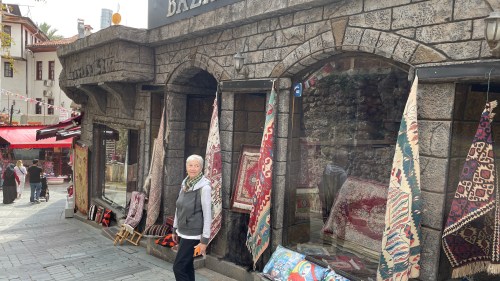It’s been two weeks since we arrived in Scotland and moved back into the campervan. In some ways we slid right back into it; in others we’ve had some adjustments to make.
From the storage place we drove directly to a caravan supply store and swapped out our empty propane bottle for a full one. Propane fuels our heat and hot water, the refrigerator, and the stove. Next we stopped at a grocery store for a few essentials for dinner and breakfast before checking into a small campground where we could fill the water tank and plug into shore power to get the fridge down to temp before we do a full food shop. After not driving anything at all for six months Jack had no problem negotiating the ubiquitous clockwise roundabouts or squeezing the van into the narrow spaces of shopping centers.

It was damp and rainy and we were the only ones at the campsite but it served our purpose as we unpacked and made a first pass at organizing. It will end up being many passes as we remember what needs to be at hand and what can be stashed away.

After a more substantial grocery run the next day we felt confident we could go offgrid and drove to a beautiful parkup at Louden Hill near something called the “Spirit of Scotland” monument. We had no idea what that is and couldn’t see anything from the van.

Early the next morning an unexpected blue sky lured me outside to follow the trail toward Loudoun Hill, a volcanic plug that dominates the landscape. This place, we learned, is the site of two key battles in the wars of Independence, led by William Wallace in 1297, and Robert the Bruce in 1307.

The Spirit of Scotland is a modern (2004) monument to these battles. The outline of William Wallace frames the hill, with the inscription “Thou saw’st the strong arm of a Wallace raised to stem the tide of alien tyranny.” It’s a dramatic addition to a dramatic landscape.


I gave up on the idea of climbing the hill because of strong wind and hurried back to the warmth and shelter of the van. I was glad I went early because it was Easter and for the rest of the day the car park and trail were crowded, despite deteriorating blustery weather with spitting rain that would have kept a normal person home by the fire with a good book. The Scots, we’re reminded, are not normal.
Our original plan was to head straight for Ireland but we’d had an unexpected spanner thrown in the works. Before we left Turkey the bank canceled my credit card without warning “on suspicion of fraud.” My card is always in my possession, I’d had no fraudulent charges, and the bank couldn’t say what convinced them the card was compromised. Despite my desperate pleas, they shut down the card and sent a replacement. To New Jersey. I was in Turkey about to travel to Scotland, with no working credit card. That’s not entirely true. I do have a backup from a less desirable bank (points and rewards-wise) and Jack has his own account, but still.
My sister, who receives our mail, promised to forward the new card to the storage address in Scotland as soon as it arrives in New Jersey, and all we have to do is hope it gets here before too long. That puts Ireland on hold while we hang around the general area until the mail arrives. We need to come up with a plan.
I chose a quiet parkup where we could stay undisturbed for a few days and we found ourselves adjacent to a UNESCO World Heritage site.

This is the village of New Lanark, founded in 1785 and built around cotton mills operated by water power from the only waterfalls on the River Clyde. The village is an important example of urban planning in the early Industrial Revolution, and includes housing for workers, schools, shops and a church. The experiment was successful, combining profitability with better living and working conditions at a time when most factory workers endured a grim existence.


It’s still too cold in Scotland for us, so after a quick turn around the village to admire the water sluices and surviving waterwheel we took refuge in the warm café on site.


The village was built long before the advent of modern vehicles and the car park is a steep uphill slog from the river. Of course I had to detour to visit the graveyard.




By the time we got home we decided to head east to Edinburgh. And we’re hoping for warmer weather.










































































































































































































